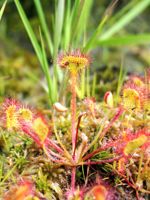Mon-Fri 9am - 5pm Mountain time
Round-Leaved Sundew vs Anise Hyssop
Drosera rotundifolia
Agastache foeniculum
CUSTOM GROW
NOT AVAILABLE THIS SEASON - MIGHT RETURN
Round-Leaved Sundew is a native carnivorous plant, easily recognized by its bright green leaves covered in distinctive red, glandular hairs. These hairs secrete a sticky substance that is used to attract, trap, and digest insects. Their carnivorous nature allows them to survive in nutrient-poor, acidic soils where many other plants may struggle to grow.
They produce small white flowers that grow along the top of a slender, leafless stem. They can be found growing in wetlands, most often among sphagnum moss, in consistently moist, acidic soils. It does best in cooler summer climates and is intolerant of shade. Due to its small size, the plant can be difficult to spot in its natural habitat. Round-Leaved Sundew is an indicator of healthy wetland systems and is valued in ecological restoration and conservation projects.
Anise Hyssop is a native perennial wildflower known for its fragrant spikes of small purple flowers. This plant is an excellent source of nectar and is highly attractive to a variety of bees and other pollinators. Deadheading spent flowers will encourage more blooms throughout the season.
Its aromatic leaves release an anise-like (licorice) scent when crushed. Both the leaves and seeds are edible and have been used in teas and as flavouring. Leaves can be harvested at any time, though the oil content is highest just past full bloom. Deer tend to avoid Anise Hyssop because of its strong-smelling leaves. This makes it a useful plant for positioning as a protective border around more vulnerable species.
Anise Hyssop spreads by seeds and rhizomes, but is less aggressive than other members of the mint family and is easy to remove if needed. Historically, it was planted in large numbers as a honey plant to support apiaries. Birds also feed on its seeds, adding to its ecological value.

